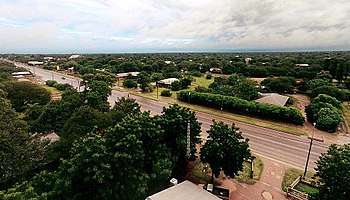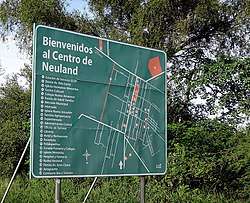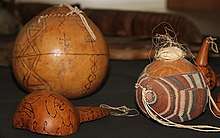Neuland
Neuland is a city in Boquerón department in Western Paraguay. Located 464 km (288 mi) northwest from the capital, Asunción, it's the smallest of the Mennonite colonies established in the central Chaco with about 2,500 inhabitants. It's a charming German-speaking small town surrounded by the desert-like environment of the Chaco. The town's plaza and museum are nicely done and those intrigued by the Mennonite culture will find this to be enough of a reason to visit Neuland. Additionally, visitors take advantage of its proximity to the Chaco War most well known historical landmark, Fortín Boquerón, located 27 km (17 mi) away.
Understand

Neuland means "new land" in German and the town's name is a good description of what was this place in the Chaco for the early immigrants when they came to Paraguay in the 1940s. Today the city is prosperous and has one of the highest living standards of Paraguay thanks to the work of the Neuland Cooperative.
History
The newest of the Chaco's three Mennonite colonies, Neuland was founded in 1947 by Mennonites escaping religious persecution in the then Soviet Union. The majority of the initial settlers were women, because the men had been sentenced to Siberian work camps by Stalin's regime after World War II. These women had fled from the Soviet Union to Germany, from where they were allowed to immigrate to Paraguay.
Economy
The Neuland Cooperative is the responsible body of the social, economic, and cultural life of the colony and run most of the city services like the bank, the supermarket, the hospital, even the museum, the only hotel in town and the tourist office are managed by the cooperative. It has also an important industry of dairy products, beef, and crop processing such as peanuts and sesame.
Practically all the Mennonite families have shares in the cooperative. Outsiders (non-Mennonites) can rent or buy land from the cooperative on condition to living one year among the community so their character can be judged. The cooperative collects a percentage of a member's earnings and in return members get use of all the benefits the cooperative offers, such as discounts at the supermarket, health insurance, elderly care, university scholarship, among others which are not provided by the Paraguayan government. They may also get financial dividends, but they will sometimes hold votes on whether to retain the dividends and invest them in new facilities and benefits.
Visitors information
- 🌍 Tourist Office, Avenida 1° de Febrero (in the cooperative headquarters), ☎ +595 493 240 201, e-mail: dorothea.dyck@neuland.com.py. Run by the Neuland cooperative the tourist office provides travel info and coordinates guided visits to the cooperative grounds, museum, and town plaza. Call ahead to be sure the tourism manager is available and the office is open.
Get in

Overland by road is the only way to get to Neuland.
By bus
Stel Turismo runs daily buses from Asunción (US$13) 7 hr, and NASA/Golondrina runs daily buses from Filadelfia and Loma Plata, from where you can catch more buses to Asunción or, if you intend to travel to Bolivia, to Mariscal Estigarribia, 98 km (61 mi) to the northwest.
By car
Neuland is 20 km (12 mi) off the Transchaco highway. The turn off is on the 450 km marker of the highway. If coming from Asunción turn left on the paved road that leads to the center of town. If you are coming from the other colonies of the central Chaco, Filadelfia is 37 km (23 mi) to the north, and if you come from Loma Plata add 27 km (17 mi) more. The Bolivia border is 327 km (203 mi) to the northwest, and the travelling time is about 7 hours.
Get around
Neuland is a small town, so there is no public transportation. Most of the city sights can be easily reach on foot as they are along Avenida 1° de febrero, the main street, and where most of the businesses, supermarkets and the hotel are located.
See


City sights
- 🌍 Museo Histórico (city museum), Avenida 1° de Febrero (200m south of the cooperative). The museum is normally closed and visits must be arranged previously at the tourist office. Of the three Mennonite city museums of the Chaco, the one of Neuland gives the best idea of how life was for the early settlers. Built as the school, the museum has been set up to resemble a typical Mennonite dwelling with a main house, a covered barn for farming equipment, and a separate building for the kitchen. There are various items used by the settlers upon their arrival including butter churns, sausage fillers, and many handmade objects that are a testament to their make it work attitute. Particularly interesting are the large egg incubators used to transport eggs during the week-long journey to the market in Asunción and a strange machine created to make ceramic bricks and tiles. Free.
- 🌍 Parque Chaco Boreal (city park), Avenida 1° de Febrero (next to the cooperative). The small, well maintained city park is the site of three commemorative statues. The first statue is of a Mennonite woman working the land and is an homage to the early women settlers who came to Paraguay seeking a new future. The second and third statues are memorials for the 25th and 50th anniversary of the colony's founding. On the far end of the plaza is a well-digging machine donated to the colony by Dutch Mennonites in 1967. This machine was used to dig more than 1000 wells in the area, a key improvement for the colonists who were digging the wells with their own hands by that time.
- 🌍 Iglesia Mennonita de Neuland (city church), Avenida 1° de Febrero (500 m south of the cooperative). Built in 1955 with the contribution of Mennonites from North America. The fact is that every member of the colony had to colaborate in the construction of the church with 17 days of work under the label of community service. After 20 months of work the church was finished. It's open for visits arranged previously through the tourist office.
- 🌍 Parque Serenata (go down Avenida 1° de Febrero 400 m down from the museum then turn left 2 blocks). Well preserved city park with lots of trees.
- 🌍 Freundschaft Park (friendship park) (at southern edge of town next to the rodeo). This park has the peculiarity that the terrain has been left in a natural state in order for visitors to have an idea of what the area looked like when the first settlers arrived.
Out of the city
- 🌍 Fortín Boquerón, 28 km southeast (take Avenida 1° de Febrero down to the southern edge of town then turn right and follow the unpaved road for 24 km and turn left 1½ km until you reach the park entrance then follow the signs.), ☎ +595 981 242420. W-Su 08:00-17:00 call ahead to ensure there will be someone to open the museum. Founded in 1928 to stop the advance of Bolivian troops, Fortín Boquerón is one of the Chaco War's most significant historic landmarks. Strategically located near fresh water reserves, the fort played a key role in the hostilities between Paraguay and Bolivia both before and during the Chaco War in 1932-35. In 1928 the fort of Boquerón was taken by Bolivia, but then taken back by Paraguay. In July 1932 Bolivia took the fort again, and in September the same year it was retaken by Paraguay in a costly and bloody siege that marked a decisive victory for Paraguay. It still took Paraguay another three years to push the Bolivians out of the Chaco, and the peace settlement was not signed until 1938. Today, it is the site of a large museum complex dedicated to the war, showcasing an extensive collection of Chaco War photos and weaponry. The premises also retain many of the original 3,800 m of defensive trenches, most about 1.5 m deep. Although they are no longer fortified with barbed wire and snipers positions, the thorny vegetation surrounding the trenches and the intense heat is enough to make you pity of the Chaco War soldiers. The tourist trail follows along the old trenches and leads to two small cemeteries for Bolivian and Paraguayan soldiers. Along the way, there are palo borracho trees whose trunks were hollowed out to create hiding places for snipers. The area along the trenches is overgrown, but at the site of the Paraguayan cemetery you will see the savannah-like cleared lands with wild grass similar to what the battlefield looked like in 1932. Presiding over the cemetery is a large, original cross. The clearing in front of the museum features an evocative statue of a Paraguayan soldier created by the famed Paraguayan artist Herman Guggiari. The site is best visited with a guide that can be hired through the tourist office in Neuland or Filadelfia. Another option is to hire a taxi for a roundtrip from either Filadelfia or Neuland. Free but tipping the museum keeper is recommended.
- 🌍 Fortín Toledo, 60km northwest of Neuland, next to the Centro Chaqueño para la Conservación e Investigación (go out of Neuland to the Transchaco highway and turn left towards Mariscal Estigarribia for 26 km until you reach the 475 km marker, turn right and keep on west for 9 km until you reach the Research and Conservation Center and continue for 1 km). A historic place from the Chaco War (1932-35) where one of the major battles of the conflict took place between 26 February and 10 March 1933. Two cemeteries, one Paraguayan and one Bolivian, honor the over 1000 soldiers from both sides who died in combat during the battle.
- 🌍 Centro Chaqueño para la Conservación e Investigación (Chaco Research and Conservation Center), 60km northwest, next to Fortín Toledo (fgo out of Neuland to the Transchaco highway and turn left towards Mariscal Estigarribia for 26 km until you reach the 475 km marker, turn right and keep on west for 9 km until you reach the entrance). A research center dedicated to the conservation of the peccary (known locally as taguá). You can see three different species of peccary up close. There is a guest house with dorm rooms and kitchen for visitors who want to stay for two or more days (booking is required). The center's location is ideal for nature enthusiast and those who want to venture into the Chaco. You need to bring all the supplies as the nearest store is in Filadelfia. Just to the left of the center is Fortín Toledo, a historic site from the Chaco War, and worth visiting.
Buy

- 🌍 Neuland Coop Supermarket, Avenida 1° de Febrero (in front of hotel Boquerón). The storefront of the Neuland Cooperative. In 1996 the original store was demolished to give place to the new supermarket-style general store. It's worth visiting to see the wide varietes of goods produced in this Mennonite colony.
- 🌍 Librería Neuland (bookstore), Avenida 1° de Febrero (next to hotel Boquerón). Books and reading materials, mostly in German language. It also sells maps and postcards of the region.
- 🌍 APICSA (honey store), Avenida Industrial (at entrance of town). The place where the honey producers sell their products. The honey from the Chaco is one of the best natural honeys in the market. It's exported to all over the country.
In the working-class neighborhood of Cayin ô Clim, where mostly members of the Nivaclé ethnic group live, there are some artisans and craft people that make carpets and bags, with designs that have been rooted in their ethnicity for many generations. They also made different wood carvings from the palo santo tree, mainly in the form of the typical animals of the Chaco like turtles, anteaters, armadillo and serpents that are very requested models.
It's recommended that visitors to the Chaco bring cash, as outside the hotel or the cooperative supermarket, only a few shops in town accept credit cards.
Eat
- 🌍 Restaurant Boquerón, Avenida 1° de Febrero (Located across the street from the cooperative), ☎ +595 493 240311. Part of the Hotel Boquerón, the restaurant has good meals, specializes in german and paraguayan cuisine. It offers a buffet for lunch.
- 🌍 Manjessi, Avenida 1° de Febrero 1280, ☎ +595 493 240464. M W-Su 18:00-23:00. Advertised as the best pizza in the Chaco. Is the city's pizza place. Popular at night. Inexpensive.
Drink
The Mennonites are very hard-working people and after dark it seems that everyone goes to bed. However, the Manjessi pizzeria offers drinks.
Sleep

There is only one hotel in Neuland so it's best to reserve ahead, specially during the Transchaco Rally competition in late September and the Expo Rodeo in May.
- 🌍 Hotel Boquerón, Avenida 1° de Febrero (Located across the street from the cooperative), ☎ +595 493 240 311, e-mail: hotel@neuland.com.py. Although is the only hotel in town, it's a very good one. With 22 rooms it has a new wing with rooms nicely done and an old wing with cheaper, shared bath rooms. The restaurant serves up decent meals and has a small lunch buffet as well.
Connect
The hotel offers Wi-Fi for guests.
Go next
The other two Mennonite colonies are close and worth visiting:
- Filadelfia is 37 km (23 mi) to the north. The largest and most cosmopolitan of the Mennonite colonies is a charming city.
- Loma Plata is 62 km (39 mi) to the north via Filadelfia. Is also a major Mennonite town, similar in size to Filadelfia. It has a large industry of dairy products.
If you want to go to Bolivia you will have to catch the Asunción-Bolivia bus at Mariscal Estigarribia. First purchase your bus ticket at Stel Turismo agency in Neuland. You will have to pay for the entire journey from Asuncion and the cost is US$65 to Santa Cruz de la Sierra. Then take the bus to Filadelfia, and then to Mariscal Estigarribia. Ask the driver to drop you off at the immigration office. You will have to wait there for the bus from Asunción to Bolivia to come. Buses normally depart from Asunción daily at 20:00 and reach Mariscal Estigarribia around 03:00. When the bus arrives the immigration officer will check your passport and issue your exit stamp. Don't board the bus without doing this as there is no Paraguayan immigration at the border. Once you have boarded the bus you will travel for 6-7 hours before you arrive at Bolivian immigration.
| Routes through Neuland |
| Filadelfia ← | N |
→ Asunción |